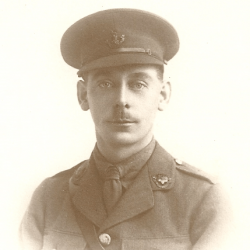William Gilbert Greenwood was born in Ashton under Lyne on May 9, 1893. His father Henry Thomas Greenwood was an accountant and financier and in later life became a member of the Ashton town Council. William had an older sister, Gladys Mary Greenwood, and a younger brother Henry Winston Greenwood. He was educated at Elmfield College, York where he was captain of the school cricket and football teams. By 1911 William was working as an accountant’s clerk in his father’s business, managing the office in Stockport, and was living with his parents and brother in Ashton under Lyne, his sister was in Southport at boarding school.
Shortly after the outbreak of war he was appointed as a Second Lieutenant in the 9th Battalion Manchester Regiment (Territorial Force), along with 10 others, on October 12, 1914. He joined the 2/9th in training at Southport before moving with them to Haywards Heath and Pease Pottage. 2/Lt. William Gilbert Greenwood was the lowest ranking, (by precedence), of the 5 Officers (and 222 men) who traveled to Gallipoli in July 1915, joining the Battalion at Cape Helles on July 23rd.
He is not mentioned in the Battalion war diary in Gallipoli but on September 20, 1915 he was sent sick to hospital in Gibralter, with enteric fever, and was invalided to the UK on October 30th.
After he recovered he rejoined the Battalion on March 24, 1916 while they were in Egypt. He was promoted to Lieutenant on June 1, 1916 and was sent to a school of instruction with the Suez Canal Transport Corps in December.
He sailed with the Battalion to France, arriving March 11, 1917 and six weeks later, on April 27th, left for 15 days leave in the UK. At this time, he was serving as a Platoon Commander, C Company, and was noted in the war diary as such at Havrincourt Wood in May 1917. In June he attended the 42nd Divisional Bombing School for two weeks. In September 1917 the Battalion was at Ypres and they took over the front line on the evening of September 10th. Late in the evening of September 11, 1917 C Company unsuccessfully led an attack on enemy lines and were forced to withdraw due to machine gun and rifle fire. Lt. Greenwood was wounded along with 9 other ranks, with 2 others killed or missing. He was sent to hospital and on September 19, 1917 was invalided to the UK. He did not return to the battalion and resigned his commission due to ill health on March 9, 1918.
After the war, on October 19, 1919 he married Ena Mawer and for a time, in 1920, they lived in Oldham but by 1928 William Gilbert Greenwood was living in Ashton under Lyne working as an accountant, serving on the town council and unsuccessfully ran as the Liberal candidate in the 1929 by-election.
Lt. William Gilbert Greenwood died in Ashton on May 9, 1969. He was 75 years old.

